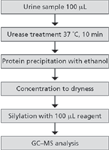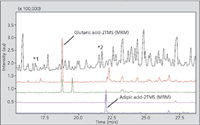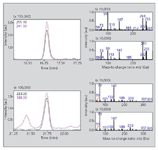Universal or Selective?
The Application Notebook
Shimadzu
A comparison of the value of different measurements in the analysis of metabolites in rat urine.
The analysis of biological samples poses special challenges on measurement technology, as the concentration of the analyte is often very small in relation to the major components (matrix). In addition, the interfering matrix has an influence on the quality of the measurements. This so-called matrix effect can affect the detection limit and/or the reproducibility of the measurement data.
In general, there are two ways to proceed: either by applying an appropriate sample preparation to minimize the disturbing matrix or by using a highly selective analysis tool.
Applying the first approach, i.e. cleaning and concentrating the sample, one has to be aware that each step of the sample preparation affects the target analyte. A precise conclusion for each compound in the sample is therefore only possible when the influencing factor of each process step in the sample preparation procedure is precisely known (for example, loss during extraction).
Choosing the second approach of selective detection, certain properties of the analyte are used to separate them from the matrix in the detection system. This has the advantage that the sample preparation can almost completely be omitted [e.g pyrolysis gas chromatography–mass spectrometry (GC–MS) or pesticide determination with QuEChERS]. In some instruments, subsequent selective and universal data acquisition can be used to selectively determine the target compounds, but non-target and matrix information are also obtained.
An example of an universal MS approach is the measurement in full scan mode, whereas the selected ion monitoring (SIM) or multiple reaction monitoring (MRM) mode in MS–MS mass spectrometry covers a selective MS approach. With regard to the comparison of different detection modes, some metabolites in rat urine were analysed using SIM, MRM and scan/MRM acquisition modes.
Sample Preparation
For sample preparation a simple and fast method developed by Matsumoto et al (1) was used. Figure 1 shows the flow diagram of the sample preparation.

Figure 1: Sample preparation procedure (1).
This simple type of sample preparation is fast and easy to perform. Its main benefit is the so-called 'planar' instead of 'linear' approach. This means that through the sample preparation itself, almost no group is discriminated, so amino acids, organic acids, sugar, sugar alcohols and nucleic acid bases can be analysed simultaneously with GC–MS. The compounds are analysed using the trimethylsilylderivative (TMS) after silylation.
Instrumental Set-up
The measurements were conducted on Shimadzu`s GCMS triple quad GCMS-TQ8030. The latest generation triple quad MS enables subsequent recording of full-scan data and highly sensitive selective single mass (SIM) or/and mass transitions (MRM) due to the scanning speed of up to 20000 amu/s and 600 MRM/s (Figure 2).

Figure 2: Comparison of the measurements in the selected ion monitoring (SIM) (left) and the multiple reaction monitoring (MRM) (right) of metabolites from rat urine.
Investigated Metabolites
The urine sample was examined in terms of the following metabolites: lactic acid 2TMS, glycerol 3TMS, glutaric acid 2TMS, adipic acid 2TMS and suberic acid 2TMS. Lactic acid and glycerol serve among others as a marker for the fructose-1, 6–diphosphatase deficiency, glutaric acid for the Glutaricaciduria type I and adipic- or suberic acid for the glutaric acid uria type II.
Comparison of the SIM and MRM Measurement
Figure 2 shows measurements of glutaric acid and the suberic acid [as trimethylsilylderivative (2)] in the urine of rats. Glutaric acid is well measured and evaluated, both in the SIM as well as in the MRM mode. The example of suberic acid makes it clear that the selectivity of the SIM measurement will not be enough to make a reliable quantitative statement.
Measurements in Scan/MRM Mode
Figure 3 shows a TIC (total ion current) measurement with subsequently full-scan and MRM data recording. Using the fast GCMS-TQ8030, it is possible to collect two bits of meaningful information from each data point. The signal of the MRM transitions yields a selective and highly sensitive signal. The fullscan spectrum with its additional Linear Retention Index (LRI) characterization provides comprehensive information in order to avoid falsepositive or false-negative evaluations. The automated library search algorithm includes the possibility to use an LRI filter. This is helpful when the library, in addition to the spectra, includes LRI information.

Figure 3: Extract from the chromatogram of rat urine recorded in full scan-/MRM mode. The black line shows the total ion current (TIC) from the full scan. The red and green shows the MRM tracks for glutaric acid are the traces of MRM; for adipic acid, blue and pink. The marks *1 and *2 show where additional metabolites from the full scan were discovered (explained further in the text).
Shimadzu's unique CID (collision induced dissociation cell) allows up to 600 MRM transitions to be achieved while also ensuring that no cross-talk occurs.
Due to the selectivity of the MRM transitions, the metabolite Glutaric 2TMS and adipic acid 2TMS could be detected easily and trouble-free, despite the high matrix. Besides the target MRM metabolite transitions, two other metabolites could be detected using the TIC trace. The peak marked *1 in Figure 3 is uracil 2TMS. Uracil is used in addition to other substances as a marker of malfunctions in the urea cycle. The peak marked *2 in Figure 3 is malic acid 3TMS which marks, in addition to other substances, mitochondrial dysfunction or dysfunction in the citric acid cycle. The extracted mass traces with full scan spectra are shown in Figure 4.

Figure 4: From the full scan extracted mass tracks for uracil 2TMS and malic acid 3TMS. In addition to the recorded part of the chromatogram, each of the appropriate mass spectrum (above) and the automatic library search results are shown (below).
Results
Particularly when analysing high matrix loaded samples like biological materials, the strength of selective analytical procedures such as GC–MS SIM or GC–MS–MS MRM have been shown. They provide excellent results, and at the same time are both sensitive and reproducible. As a valuable side effect of selective measurement the sample preparation can be reduced to a minimum. The discussed measurement method combines selectivity with universal measurements, so that comprehensive and reliable results are provided via MRM and full-scan information within a single analytical run were obtained. The MRM information could be used for quantitative target analysis, as it yields the highest sensitivity and selectivity. The full-scan information with LRI was used for clarification of the metabolite results to avoid any false positive or negative results due to the high matrix and provided additional nontarget information.
References
(1) I. Matsumoto, T. Cow, Mass Spectrom. Rev. 15, 43–57 (1996).
(2) Shimadzu application data sheet, no. 59–61.
Shimadzu Europa GmbH
Albert-Hahn-Strasse 6-10 47269 Duisburg, Germany
tel. +49 203 7687 0 fax +49 203 766625
Email: shimadzu@shimadzu.eu
Website: www.shimadzu.eu


.png&w=3840&q=75)

.png&w=3840&q=75)



.png&w=3840&q=75)



.png&w=3840&q=75)








